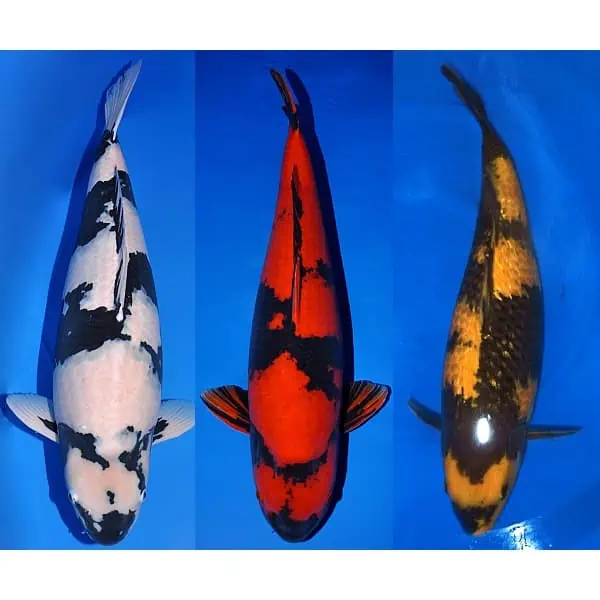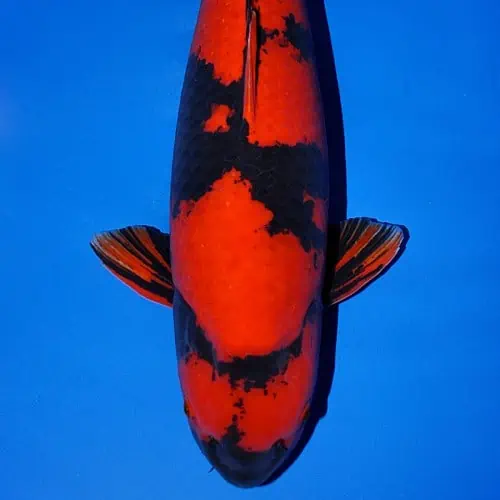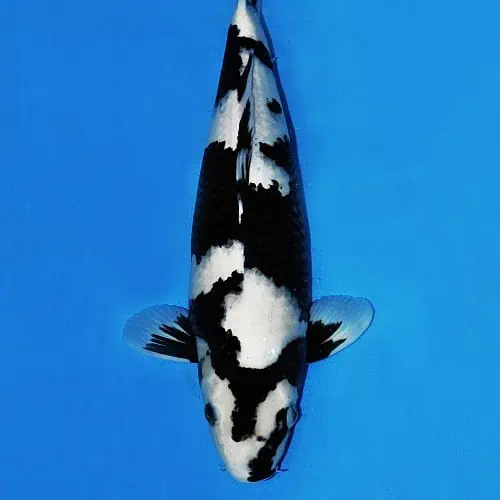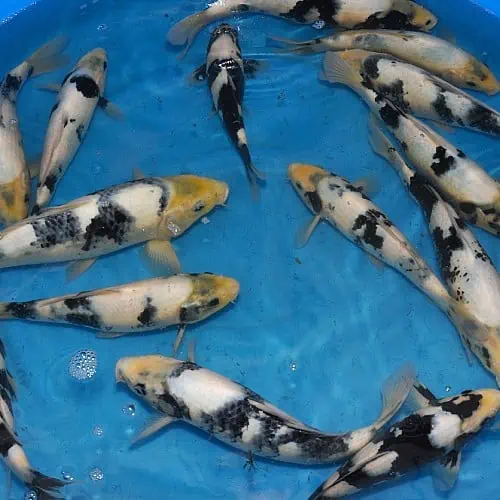
With well over 100 different varieties and sub-varieties, it may not come as a surprise that koi carp have been around for thousands of years! Most modern koi breeding practices originated in China and Japan around the 4th century, with modern mtDNA sequencing supporting the commonly held belief that koi are descendants of the common carp (Cyprinus carpio). This meticulous, detailed sequencing traced all koi carp descendants back to East Asia (an idea that was often argued), meaning that this is where the common carp originated.
Over the last 1,600 or so years, the aquaculture industry has prospered under the explosion of breeds, patterns, and colorations of koi available. In fact, the aforementioned DNA studies were also able to pinpoint that the large scale domestication of carp and subsequent breeding of them to obtain brightly colored varieties and unique patterns occurred in China beginning around 6,000 B.C.
These colorful, specially bred carp came to be known as “koi,” and were most often gifted to those with political and economic power as a gesture of good will and peace. This is how they initially made their way to Europe and, eventually, the Americas, becoming beloved pets rather than symbols of power and wealth.
The Utsurimono koi, also known simply as Utsuri, was originally derived from Showa koi over 100 years ago. The three specific varieties of Utsuri – the Ki Utsuri, Hi Utsuri, and Shiro Utsuri – took about 25 more years to breed and develop. Their striking appearance and old lineage mean that they are sometimes entered into competitions with the Big Three: Kohaku koi, Showa koi, and Sanke koi.
What Does Utsurimono Mean?
Utsurimono loosely translates to “reflection” or “shiny” (Utsuri), and “thing” (mono), and references the bright nature of Utsurimono koi’s scales. Like their close Showa relatives, Utsurimono koi have a great deal of bold sumi (black) as their base, but unlike Showa are accented by just one other vibrant color that can either be red, yellow, or white.
Utsurimono Varieties & How to Identify Them

There are three primary Utsuri varieties. These are Ki Utsuri, Hi Utsuri, and Shiro Utsuri. Within these three primary varieties, other established variations can exist, such as Kin Gin Rin and Doitsu.
1) Ki Utsuri
Ki Utsuri have a black base with yellow as the accent color. This was the first specific Utsuri variety to be developed, becoming a set variety somewhere between 1899 and 1920 (the exact years are contested). These koi were originally named Kuro Ki Han, which translates approximately to “black and yellow markings.” Its current name translates to “yellow reflection.”
2) Hi Utsuri
Hi Utsuri, as might be guessed, have a black base with vibrant red as the accent color. This breed became establish in 1924, and translates to “red reflection.” Both Hi Utsuri and Ki Utsuri often have fins with black striping.
3) Shiro Utsuri
Shiro Utsuri have a black base with bright white as the accent color. They also became established in 1924, and their name translates to “white reflection.” Shiro Utsuri have fins with Motoguro, meaning that the base of their pectoral fins are black.
4) Doitsu Utsuri
All types of Utsurimono, whether Ki, Hi, or Shiro, can be Doitsu. A Doitsu koi is one that lacks scales, with pigmentation and patterning existing solely on its skin. While often not as coveted as Utsuri with scales, Doitsu Utsuri can be striking and incredibly unique.
Doitsu koi can be traced back to late 1800s Germany, where common German carp were purposely bred over time to be scaleless for easier cooking. Around the same time, they began being exported to Japan as an easy for source, but some found them to be visually interesting and began incorporating them into existing koi lineages.
5) Kin Gin Rin Utsuri
Kin Gin Rin koi are koi that have metallic scales, and virtually any koi variety can be Kin Gin Rin. Specifically, Kin Rin koi have scales with a reflective golden or sometimes bronze hue, while Gin Rin koi have silvery or shiny white scales. Because of this, only Ki Utsuri and Shiro Utsuri can be Kin Gin Rin.
6) Kage Utsuri
Kage Utsuri have the usual solid black base patterning with either Hi, Ki, or Shiro as the accent. What sets them apart is smoky, reticulated black shadows that lay atop their accent colors, faint enough that you can see through to the color beneath. In fact, “Kage” translates literally to “shadow.” Like all koi, Kage Utsuri can be normal, Kin Gin Rin, or Doitsu.
How to Appreciate & Judge Utsurimono Koi

The judging of Utsuri depends somewhat on the location and the judges themselves. In Japan, judging can be more subjective and having been in the koi industry for so long, some judges may have a bit of bias based on bloodline. For example, it’s possible that a judge in Japan may ignore some physical characteristics if they recognize a particularly expensive or old bloodline. So a fish may lose in Japan for being less expensive, but could win elsewhere based on other factors. Oftentimes, the exact criteria are adjusted based on the judges.
Overall, though, there are generally a particular set of guidelines that are followed when appreciating and judging Utsuri koi.
General Guidelines for Judging Koi
The fish should not have any abnormalities, such as missing fins, misshapen mouth, or bruises (unless they were accidentally caused during transportation). Utsuri should also not have any parasites, ulcers, or other forms of illness.
Symmetry is also of great importance. The way that the Sumi are arranged from front to back and side to side should be balanced and fairly symmetrical (not strictly symmetrical). Patterns that are unique are also favored. The fish should also have a proportional, symmetrical head with proportional, symmetrical fins, and a torpedo-shaped body.
Utsurimono Specific Judging Guidelines

Regardless of the exact variety, Utsurimono should have deep, ink-black Sumi and a vibrant, bright accent color (whether red, yellow, or white) with well-established, crisp edges. The Sumi should wrap boldly past the lateral line, or the faint line of scales running horizontally along the koi’s ribs that separates the top from the bottom of the fish.
Ideally, Utsuri will have some form of Sumi patterning on the head. Competitions favor those with Hachiware Sumi on the head (a lightning bolt-like pattern) or Menware Sumi (a distinct “V” shape). Some Utsuri may have Hanazumi, or a black dot on their nose, and whether or not this is favored again depends on the judges and specific competition.
Additionally, an ideal Utsuri will have a checkerboard-like pattern of color (called Ichimatsu), alternating between the black and its accent color. This is not absolutely necessary, as it’s quite difficult to achieve, but at the very least colors should be balanced and each color should compose 40 to 60% of the Utsuri. More than 60% or less than 40% Sumi or accent color will result in an Utsuri that looks unbalanced and boring. While historically Utsuri had closer to 60% Sumi, more modern breeding is favoring Utsurimono with closer to 40% Sumi and more accent color.
On Shiro Utsuri, the Shiro (white) plates should be a snowy, bright white, not off-color or yellowy. The Sumi should be in well-defined bands. In Ki and Hi Utsuri, which have not been as fine-tuned as Shiro Utsuri (the most popular and widely bred of the 3 varieties), it’s generally alright to have a bit of black spotting on the body, though simply having thick bands of black is preferred. The red in Hi Utsuri should be quite red with no orange tinge, while the yellow of Ki Utsuri can be quite yellow, or slightly orange if it’s Kin Rin.
As for extremities, it’s generally regarded as favorable to have at least some accent color on the tail. Some judges prefer a bit of Sumi on the tail as well, while others do not. As mentioned above, Shiro Utsuri should have pectoral fins with Motoguro, or a bit of black at their base where they connect to the body. Ki and Hi Utsuri should not have Motoguro on their pectoral fins, but rather black banding or stripes. The coloration of pectoral fins, regardless of variety, should match – one entirely black fin and one with bands of accent color would likely be rated as lower quality by judges.
Keeping Utsurimono – Health, Growth & Diet
1) Utsurimono Water Quality
Utsuri koi, much like other koi varieties with vibrant colors, are more obviously sensitive to water quality parameters. We say “obviously” because you will be able to visually tell by looking at your Utsuri if your parameters are off. For example, a diet too high in color enhancers, like spirulina, will cause the white portions of a Shiro Utsuri to take on more of a yellow tint. It can also cause off-color spotting in the red portions of Hi Utsuri. Water that has a higher KH (water hardness) and pH often results in Utsuri with darker, inkier-looking Sumi.
Like most koi, Utsuri needs are best met when water temperature is 50° F to 78° F (10° C-25° C), pH is between 7.5 & 8.5, dissolved oxygen is above 7 parts per million (ppm), salinity is kept very low between .05 & .15 parts per trillion (ppt), and there are only 75 to 100 ppm of total dissolved solids (TTDS), such as metals, minerals, salts, and sulfates.
2) Price of Utsurimono
If you’re considering purchasing an Utsurimono, keep in mind that they are often more expensive fish due to specialized breeding. Their greater water quality needs must also be taken into consideration, as you’ll need to have proper filtration and aeration features in place that will range in price depending on the size of your pond. We’ll cover prices of Utsurimono more in depth in a moment.
3) Utsurimono Temperature
Though lacking solid scientific evidence to back this up, some argue that water temperature plays a role in the appearance of Utsuri. Apparently, colder water lends to Utsuri with darker red or yellow coloration, while warmer waters lend to more vibrant hues. As mentioned previously, Usuri prefer water temperatures between 50° F to 78° F, or 10° C to 25° C. Additionally, make sure that your pond has varying depths to allow for your Utsuri, and any other koi, to swim to different depths to help naturally regulate their body temperature as needed.
4) Utsurimono Diet
To help develop and maintain healthy coloration, Utsuri koi are often fed diets with color enhancers, such as those containing spirulina or krill, as well as those with ample (>30%) protein to aid in proper growth. These are of lesser importance if you don’t wish to show your fish at shows. Otherwise, though, the dietary needs of Utsuri are much the same as most other koi.
How to Breed Utsurimono Koi

If you’re looking to breed your Utsuri for the purpose of obtaining a specific variety or scale type, do keep in mind that this can be tricky. Simply due to the nature of genetics and the incredible amount of chance and nuance involved in coloration alone make it very difficult to obtain exactly what you’re looking for, unless you’re a professional with an established line of Utsuri.
One study conducted on the genetics of red and black color inheritance found that, for Ki Utsuri koi, there are three phenotypes and over a dozen alleles involved in just expressing red coloration alone! These three phenotypes determine whether the koi is colorless, completely red, or red patterned. Similarly, there are three phenotypes that determine black coloration: colorless, Bekko pattern (a little black), and Utsuri pattern (a fair amount of black). In fact, breeding two Utsuri koi is only 16% likely to yield Utsuri offspring! Trying to obtain an Utsuri from non-Utsuri parents, such as Showa, is even more difficult and rare to achieve.
This is partially why Shiro Utsuri are more common, as they tend to be easier to breed, and why Ki and Hi Utsuri are more rare and have less well-established patterning and color. Breeding also factors into cost, discussed below.
What is the Cost of Utsurimono & Where to Buy Them?

Despite being more popular, Shiro Utsuri tend to be less expensive while Hi Utsuri is the most expensive, and Ki Utsuri is usually somewhere in the middle. Among sub-varieties of Utsurimono, Kin Gin Rin and Kage are the most expensive. As mentioned above, this relates back to the difficulties involved in breeding exact varieties. Among all Utsurimono varieties, getting a younger fish is less expensive, as they are not done developing and the true extent of their color and patterning is typically yet to be determined.
To get an adult Kin Gin Rin or Kage Utsuri, expect to pay over a thousand dollars or pounds. This drops down to a few hundred dollars, on average, if you get a juvenile, though a very young Kage Utsuri may not appear to be Kage until it gets older. Because of their rarity, Hi Utsuri can be even more expensive than Kin Gin Rin, Kage, and Doitsu Utsuri!
Regardless of the variety, they will be cheaper as juveniles and it’s possible to find good-quality, young Utsuri for under 100 dollars or pounds. There is a bit of a gamble here as colors are not yet fully developed, but this is less of a concern if you’re not seeking to show your fish in competitions. No matter what type of Utsuri you get, it’ll make a fantastic and beautiful addition to your pond!
Be sure to purchase Utsuri, or koi of any type for that matter, only from reputable breeders. Oftentimes, cheaper koi come from large fish farms or shady operations that don’t prioritize the health and wellbeing of the fish. Koi from non-reputable sources could be mistreated or have illnesses or parasites from being stocked with too many other fish or not being care for properly.

